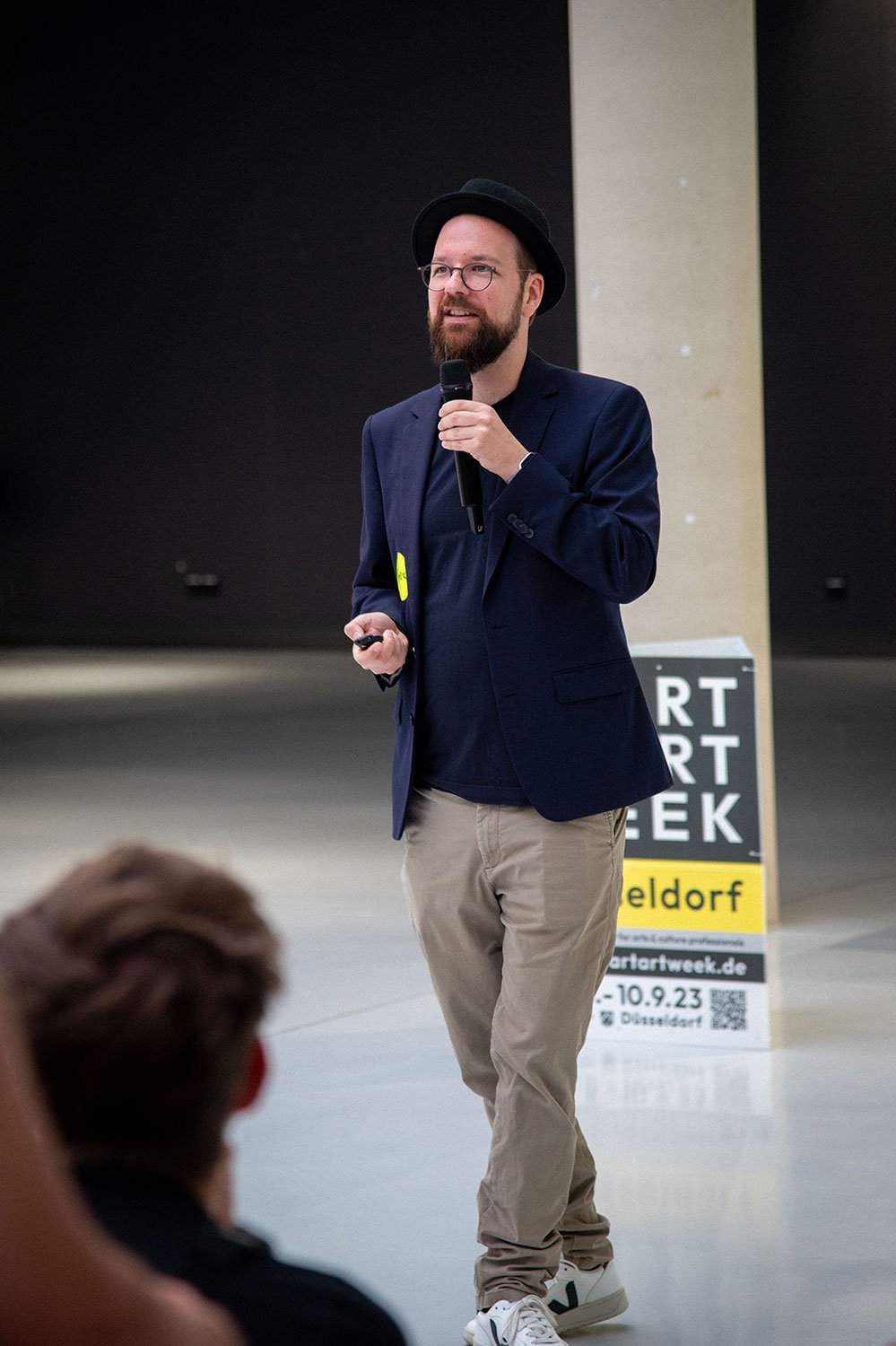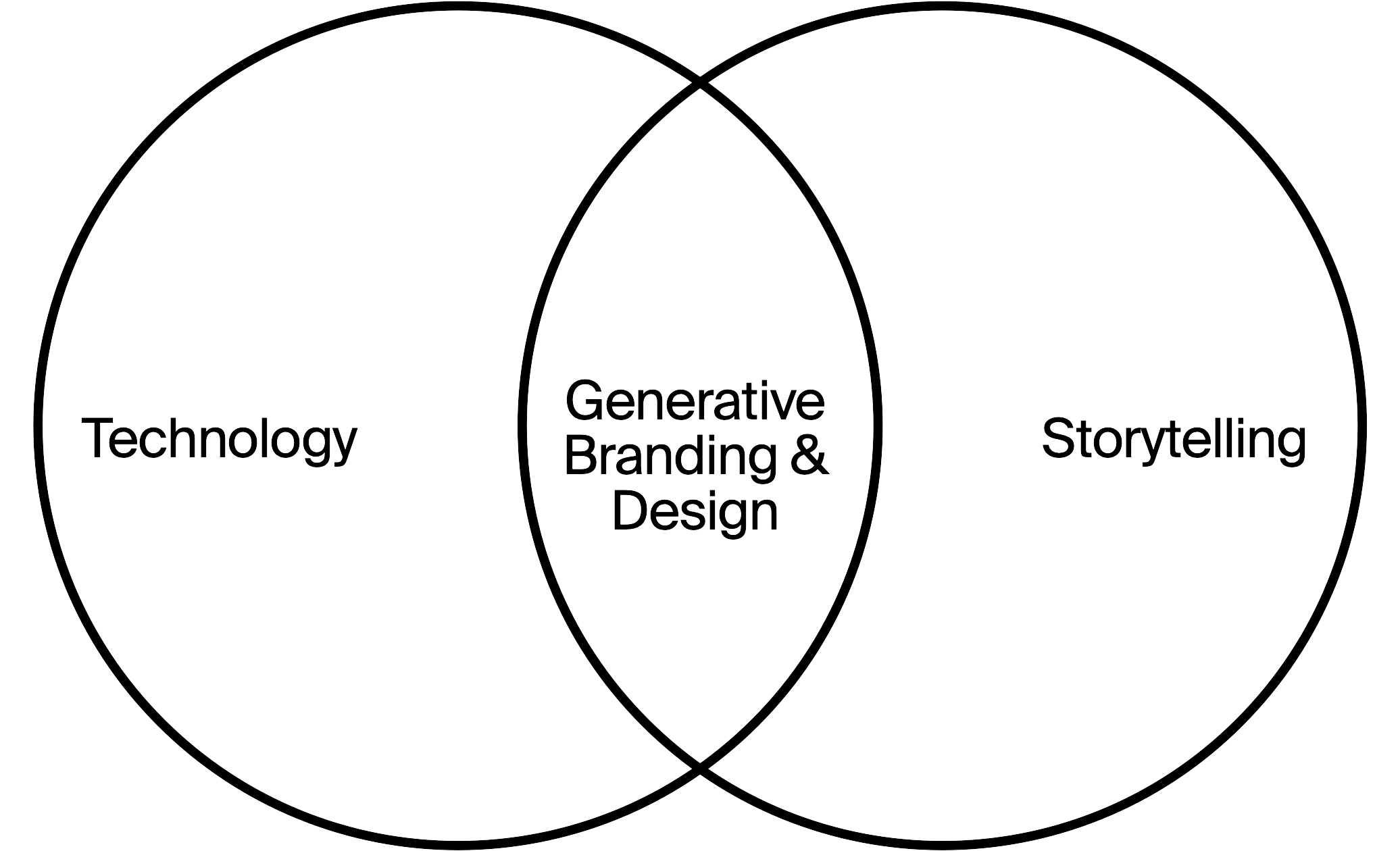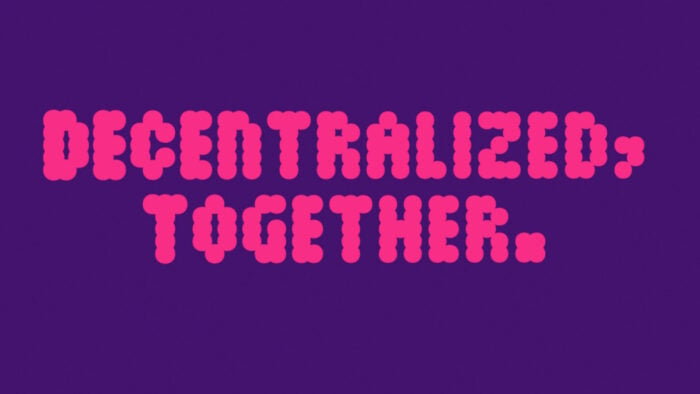Creative, constructive, catastrophic? What is the role of creative professionals in times of artificial intelligence?
As a programming designer and creative director, Patrik Hübner has been working at the intersection of brand communication and technology for over 15 years. Working in traditional design for years, he discovered Creative Coding as a creative method in 2014. Today he works as a generative designer with international brands, agencies and cultural institutions. As a lecturer at universities, he teaches on the topic of generative design, is a regular keynote speaker and gives workshops. In the run-up to the event “Creative, Constructive, Catastrophic? A productive conference on the current AI hype” he spoke about the role of cultural and creative professionals in times of artificial intelligence. This interview was originally conducted in German as part of the creative talks-series by creative.nrw. You can read the original German version here.
You learned programming as a teenager before you became a designer. As a generative designer, you now combine these seemingly contradictory professions. The method is called Creative Coding. How exactly does it work, and what does the creative part look like?
In my work, I combine design with programming. To do this, I use creative coding and generative design – but there are differences between the two disciplines:
Creative Coding is about free exploration. You could say it’s a reflection on technology itself. A play with code and design, and an invitation to combine the two worlds. Unlike in classical programming, in Creative Coding mistakes are not annoying, but welcome, because they often produce exciting results, lead an idea in new directions and me step by step to a goal I never set. This process in itself is very creative.
Generative design is, for me, rather purpose driven. I use the method specifically to find solutions to a particular problem – for example, within a design project. I’ve been interested in human behavior since I was a child and have always enjoyed solving puzzles. In generative design, these two interests come together. Music visualization was therefore the perfect introduction for me to the world of programmed design. It gave me the opportunity to make graphics, which I created via creative coding, interact with people in real time. By playing them live to the music, I put my visuals into a dynamic context that was in motion. I made them react to the music and the mood of the visitors, and I was thrilled by the fascination this caused in people. It was during this time that I understood that data – in the form of sounds, for example – can be the impetus for design. Today it seems obvious to me. Back then, it changed everything.
For me, both creative coding and generative design are clearly creative activities. In both fields, it’s about approaching a graphic vision through programming and being surprised again and again by the results along the way. It’s a kind of co-creation with the machine.

Patrik at age 11. He taught himself how to code in this early youth. This led him to experience technology as something that could be shaped and to question how the computer could be involved as an active ‘partner’ in his creatvie and design process.

Patrik, delivering the opening keynote at the event “Creative, Constructive, Catastrophic? A productive conference on the current AI hype” on September 7, 2023 in Düsseldorf.
After years of classic agency work, you now specialize completely in generative design and use it to develop brand experiences on an international level. Where do you see the added value in generative design? Can you give an example?
Of course. The focus of my work with generative design is on branding and thus the field of communication design. At its core, it’s about developing dynamic brand identities and bringing content – at best using stories – into contact with people. This can of course also be achieved with traditional design. Generative design, however, offers the advantage of actively incorporating data – and thus real events – into the design process. This aspect forces designers to think differently about themes and products. As a generative designer, I don’t focus my attention directly on the final form – the poster or animation, for example – but build a system in which many possible forms can emerge through the integration of data. To do that, I have to ask myself different questions: What constitutes the product I’m working with? How does it come about? What lies at its core? It’s about figuring out what data I can use to tell stories, and only then, together with the program, exploring visual outcomes.
Globalization, Big Data, Artifical Intelligence (AI) – no matter if private or professional, we’re confronted with a multitude of topics that seem almost impossible to grasp with existing models of thinking. At the same time, as cultural and creative professionals, we’re facing technological threats that could replace our work in the long term. So, what can we do?
This approach, and the variety of media that generative design can use, creates new types of storytelling. Customers may initially feel that they are told similar stories, but because the narrative of generative design is fundamentally different, they can experience the topic or product in a completely new way. This offers companies the opportunity to differentiate themselves from the market in terms of visual output and content. It’s literally a new way of telling stories and thus drawing attention to products, brands, events or services.
Another – perhaps more obvious – added value of generative design is automation. Since I, as a generative designer, don’t design the final form, but rather use a program to develop a system that does the design for me in the end, I can generate a whole series of deliverables on the fly. That’s an accomplishment that would never be possible under traditional conditions. What’s more, I can design the system so that it can be used by non-experts. By letting the program take care of the design and thus avoiding possible errors in form, there is no longer any need to ask designers for every little brand element.

What role does artificial intelligence play in generative design?
Generative design is a discipline that creates design from ideas through rules. It is a method within which artificial intelligence is but one of many tools you can use.
As a generative designer, I was previously limited to working with quantitative data – that is, data that the machine can work with because it can be objectively measured and expressed in numbers – for example, the length of a text in words or letters. Qualitative data – such as the mood of a text – previously had to be interpreted by humans before it could be used for programmed design. Today, Artificial Intelligence (AI) can recognize patterns and interpret data. As a result, qualitative data now becomes something that I can use, allowing me to implement entirely new ideas. Furthermore, as a generative designer, I was traditionally limited to working with abstract, computer-generated shapes and predetermined footage. The possibility of generative image synthesis through artificial intelligence enables me to explore new, more multi-layered modes of expression in generative design here as well.
In the end, the benefit of Artificial Intelligence in generative design comes from its ability to recognize patterns and regularities in large amounts of data, which can then be used to create something new. For me, it is not a stand-alone solution or application, but a tool that, in the right hands and with the right understanding, can help you create great things.
As a programming designer, you have the reins of technology in your own hands. Many creative people from other disciplines feel threatened by generative artificial intelligence because their activities can be partially taken over by machines. How do you think creatives can hold their own in the age of AI – what role do they play and will they play in the future?
That’s a difficult question, because of course none of us can predict the future. I’m probably speaking from a very privileged position here because I feel at home in both programming and design. This has already given me many advantages and will certainly continue to do so in the face of current technical developments.
I think there is a very real chance that some of the tasks designers perform will become automated in the long run. For me, this is a positive development because it liberates my mind and gives me room to think more broadly and expand my skills. For people who love doing these jobs and have no interest or opportunity to explore new areas or invest in their development however, it’s definitely a risk. I don’t have a solution to this problem, but I think it’s imperative that creative professionals develop an understanding of where the strengths of the human and where the weaknesses of the machine lie and apply the results to their line of work. For me, it’s about investing in those very ‘human’ skills, because in the end we work together with the machine, and teams are most effective when their members complement each other. I think it is important to realize that in the context of these developments design plays an incredibly important role: It makes the changes within our world tangible. Technological and social changes are always reflected in the (product) designs of their time. It was certainly no coincidence that the worldwide hype about AI culminated with the publication of generative image synthesis.
Generative design is a discipline that creates design from ideas through rules. It is a method within which artificial intelligence is but one of many tools you can use.
In this context, I’d like to mention a paper by Jochen Viehoff. He is the director of the Heinz Nixdorf Museums Forum – the largest computer museum in the world, which happens to be in my hometown of Paderborn. Together with Georg Trogemann, he has written a dissertation about programming as an artistic practice. The authors refer to creative artists as makers of the present. Makers, that are not only compelled but even obliged to face new challenges. I would even go further and say that they are the makers of the future, because no matter in which field they are active, it is usually about shaping the world in which we now live in and will live in in the future. I see it as our collective challenge to become aware of this responsibility, to face it and to accept it with joy, curiosity and motivation. I’m an optimist when it comes to these challenges so I feel we should view this not in terms of dangers, but in terms of possibilities.
Do you yourself personally perceive dangers in the rapid development of digital technologies? And if so, how do you think they can be addressed?
I’m an optimist first and foremost – but as with every technical development, artificial intelligence also poses challenges that we as humans must tackle together. For me, designers play a central role here, because we actively shape the future through the surfaces we use to operate the technologies. By giving technologies a form, we make them usable for the general public. This puts a lot of responsibility on us.
Design influences how we see our world and what is important to us. If processes are increasingly automated at this very position, it opens the door to circulate all kinds of messages. Here, I think people need much more media literacy to recognize the principles that are used for positive and negative manipulation.
In the area of programming, I actually see a trend that could become dangerous in the long term. More and more systems are emerging that write code on their own. It is not unusual for programmers to copy and use existing solutions, but if computer code is now only synthesized and used by machines, the results may become increasingly incomprehensible to humans.
I think it is important to realize that specific AI-solutions will (at least eventually) always be faster than us, it’s impossible to keep up. So we don’t have to compete. But we also shouldn’t blindly use the machine’s output. If we understand how AI-systems work, we can interact with them on a deeper level, anticipate what will come out of such a collaboration, and reposition ourselves as creatives and designers.
















